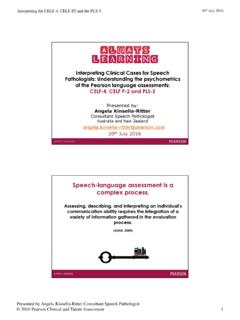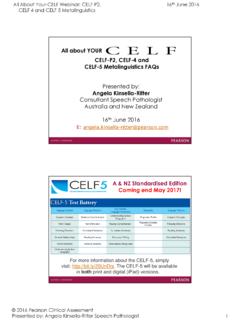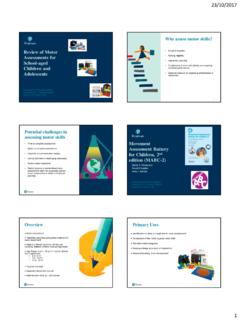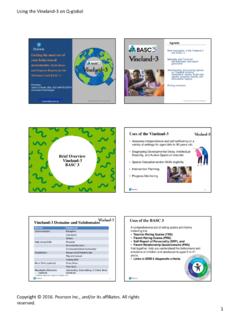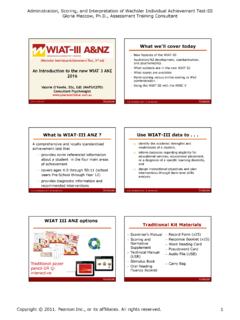Transcription of Accurately Interpreting Test Results when Assessing ...
1 Accurately Interpreting Test Results when Assessing Young PreschoolersPresented by: Angela kinsella -RitterConsultant Speech Pathologist, Pearson Clinical Assessment21stOctober 20161 | Copyright 2014. Pearson and its Affiliates. All rights reservedPresented by:Angela kinsella -RitterConsultant Speech PathologistAustralia and New Zealand21stOctober 2016E: Interpreting Test Results when Assessing PreschoolersOverview Provide an overview of PLS-5 and CELF Preschool-2 development to assist clinicians to better understand the test items, research samples, and test Results . Guidelines for Interpreting test Results will be provided so that clinicians can make appropriate programming recommendations for the children they are Interpreting Test Results when Assessing Young PreschoolersPresented by: Angela kinsella -RitterConsultant Speech Pathologist, Pearson Clinical Assessment21stOctober 20162 | Copyright 2014.
2 Pearson and its Affiliates. All rights reservedSpeech-language assessment is a complex process. Assessing , describing, and Interpreting an individual s communication ability requires the integration of a variety of information gathered in the evaluation process.(ASHA, 2004)PLS-5 can be used to.. Determine presence of a language delay/disorder. Ages birth to 7:11 Determine whether child has receptive or expressive language delay/disorder, or combination of both Determine eligibilityfor early intervention or speech/language Interpreting Test Results when Assessing Young PreschoolersPresented by: Angela kinsella -RitterConsultant Speech Pathologist, Pearson Clinical Assessment21stOctober 20163 | Copyright 2014. Pearson and its Affiliates. All rights reservedWhat skills does PLS-5 target?Assess a wide range of developmental communication skills Preverbal skills Attention to environment and people Play Vocal development Social communication Gesture Language content and structure understanding and using concepts Understanding and using morphosyntactic forms Integrative language skills (thinking using language) Analogies Similes Categories Semantic absurdities Theory of Mind Emergent literacy Book handling Phonological awareness Letter identificationPLS-5 can be used to.
3 Identify both receptive and expressive language skills in the areas of: Attention, gesture, play, vocal development, social communication, vocabulary, concepts, language structure, integrative language, and emergent literacy. Identify a child s language strengths and weaknesses to develop appropriate Interpreting Test Results when Assessing Young PreschoolersPresented by: Angela kinsella -RitterConsultant Speech Pathologist, Pearson Clinical Assessment21stOctober 20164 | Copyright 2014. Pearson and its Affiliates. All rights reservedProgress MonitoringTrack Progress Measure efficacy of Speech-language treatment and interventions Use Growth Scale Value (GSV) to track progress of child s skills on the same instrument Can be given at each time child transitions to new developmental periodDevelopmentally and Culturally Sensitive Methods of Assessment PLS-5 allows multiple assessment methods for giving credit (Birth 2:11) Caregiver Report Observation Elicitation Allows for observation of naturally occurring behaviours and spontaneous language in unstructured format.
4 Dialectical VariationsAccurately Interpreting Test Results when Assessing Young PreschoolersPresented by: Angela kinsella -RitterConsultant Speech Pathologist, Pearson Clinical Assessment21stOctober 20165 | Copyright 2014. Pearson and its Affiliates. All rights reservedOrganisation of the TestNorm-referenced Scales Auditory Comprehension Scale Expressive Communication ScaleSupplemental Measures Language Sample Checklist Articulation Screener Home Communication QuestionnaireItem Criteria for PLS-5 is Developmentally Sensitive Birth 11 months old Items represent behaviours that are precursors to language Caregiver involvement to maximise performance and caregiver reporting to ensure credit for skills. 1 2 years old Use of manipulatives and play for more authentic assessment Scoring of spontaneous interactions 3 4 years old Engagement in interactive behaviours Practice items level field for children without school or testing experience 5 7 years old Integration of knowledge and language skills Evaluation of emergent literacy and academic skillsAccurately Interpreting Test Results when Assessing Young PreschoolersPresented by: Angela kinsella -RitterConsultant Speech Pathologist, Pearson Clinical Assessment21stOctober 20166 | Copyright 2014.
5 Pearson and its Affiliates. All rights reservedDialectal VariationsAppendix ETechnical Information Demographic Information Over 1800 children were tested for standardisation and related reliability and validity studies from December 2009 through August 2010. The standardisation data were collected by 189 clinicians in 42 states in the United States. Validity Clinical studies Ages 1-2:11 - language delay study Ages 3:0-7:11 - language disorder study Sensitivity/specificity Changes in PLS-5 that affect scoresAccurately Interpreting Test Results when Assessing Young PreschoolersPresented by: Angela kinsella -RitterConsultant Speech Pathologist, Pearson Clinical Assessment21stOctober 20167 | Copyright 2014. Pearson and its Affiliates. All rights reservedSample mirrors March 2008 Update of the Census: Race/EthnicitySample mirrors March 2008 Update of the Census: Parent EducationAccurately Interpreting Test Results when Assessing Young PreschoolersPresented by: Angela kinsella -RitterConsultant Speech Pathologist, Pearson Clinical Assessment21stOctober 20168 | Copyright 2014.
6 Pearson and its Affiliates. All rights reservedSample mirrors March 2008 Update of the Census: RegionWhere Children in the PLS-5 Sample Spend the Majority of their DayAccurately Interpreting Test Results when Assessing Young PreschoolersPresented by: Angela kinsella -RitterConsultant Speech Pathologist, Pearson Clinical Assessment21stOctober 20169 | Copyright 2014. Pearson and its Affiliates. All rights reservedAre children with disabilities included in the PLS-5 sample?Clinical Study: Developmental Language DelayScales and Total NMeanDev. Lang. DelayMean Nonclinical Matched Sample Diff. tStandard DifferenceAuditory Comprehension23 ** Communication23 ** Language23 ** **p<.01 Accurately Interpreting Test Results when Assessing Young PreschoolersPresented by: Angela kinsella -RitterConsultant Speech Pathologist, Pearson Clinical Assessment21stOctober 201610 | Copyright 2014.
7 Pearson and its Affiliates. All rights reservedClinical Study: Receptive/Expressive DisorderScales and Total DisorderMean Nonclinical Matched Sample Diff. tStandard DifferenceAuditory Comprehension66 ** Communication66 ** Language66 ** **p<.01 Diagnostic Accuracy and Clinical Use Sensitivity in classification of disorders, the cases in which a disorder is detected, when it is, in fact, present Specificity in classification of disorders, the cases for which a diagnosis of disorder is rejected when rejection is warranted.**Standards for Educational & Psychological Testing(1999) Accurately Interpreting Test Results when Assessing Young PreschoolersPresented by: Angela kinsella -RitterConsultant Speech Pathologist, Pearson Clinical Assessment21stOctober 201611 | Copyright 2014. Pearson and its Affiliates. All rights reservedSensitivity/Specificity/Predicti ve PowerACECT otalCut Score SD and Predictive PowerMatched Sample 50%Matched Sample 50%Matched Sample 50%-1 : Positive Predictive PowerNPP: Negative Predictive Power Start Points and Developmental Tasks Accurately Interpreting Test Results when Assessing Young PreschoolersPresented by: Angela kinsella -RitterConsultant Speech Pathologist, Pearson Clinical Assessment21stOctober 201612 | Copyright 2014.
8 Pearson and its Affiliates. All rights reserved Start Points and Developmental Tasks Accurately Interpreting Test Results when Assessing Young PreschoolersPresented by: Angela kinsella -RitterConsultant Speech Pathologist, Pearson Clinical Assessment21stOctober 201613 | Copyright 2014. Pearson and its Affiliates. All rights reservedPLS-5 Scores Auditory Comprehension | Expressive Communication| Total Communication Standard scores Percentile ranks Growth Scale Values Age equivalents Articulation Screener Research-based criterion scores by agePLS-5 Scores77 Accurately Interpreting Test Results when Assessing Young PreschoolersPresented by: Angela kinsella -RitterConsultant Speech Pathologist, Pearson Clinical Assessment21stOctober 201614 | Copyright 2014. Pearson and its Affiliates. All rights reservedQualifying a Child For Services You can qualify a child for services using standard scores and percentile ranks for each of these scores:oAuditory ComprehensionoExpressive CommunicationoTotal Language You should not use age equivalents to qualify a child for servicesoAge equivalents do not provide information about percent delay or a child s relative rank or standing within a group of age peersoAge equivalents do not provide the information you need to determine if a child has a language disorder Growth Scale Values Based on an equal interval scale Measure of development on a continuum Compare a singletest across multiple administrations (not across tests ) Ideal for making comparisons across administrations covering multiple developmental milestones and ages Measure growth and track the progress of individuals.
9 To evaluate the efficacy of speech-language related interventions and programsAccurately Interpreting Test Results when Assessing Young PreschoolersPresented by: Angela kinsella -RitterConsultant Speech Pathologist, Pearson Clinical Assessment21stOctober 201615 | Copyright 2014. Pearson and its Affiliates. All rights reservedWhat are Growth Scale Values GSVs enable you to compare a child s performance across multiple PLS-5 administrations over time Normed scores that provide an equal interval scale that you can use to quantify small improvements in language skills Have a theoretical range of 100-900, with a mean of 500 and a standard deviation of 100 PLS-5 growth scale values range from 138 to 562 Use GSVs to track a child s progress on PLS-5 from birth to 7:11 compare performance to performance on previous PLS-5 administrations measure treatment efficacyInterpreting Growth Scale Values Patterns of GSV changes Scores increase refinement or mastery of new skills depressed performance on initial test guessing Scores about the same child tested before developmental changes or effects of intervention have occurred Plateau in certain language skills ( increase in morphological skills, but no additional morphological skills targeted in tasks at the child s age level) Scores decrease may reflect characteristics of the disorder ( autism, hearing impairment) depressed performance on second test progressive or degenerative condition.
10 Additional traumaAccurately Interpreting Test Results when Assessing Young PreschoolersPresented by: Angela kinsella -RitterConsultant Speech Pathologist, Pearson Clinical Assessment21stOctober 201616 | Copyright 2014. Pearson and its Affiliates. All rights reservedEvaluatingGSVs relative to Standard Scores Over Time Changes in SS indicate how the child is performing relative to same-age peers Changes in GSV shows gains the child has made since the previous assessment(s)Scoring and Interpretation51744706679902813-10498416 713-763 751 5 7067137856763 7411 4 Accurately Interpreting Test Results when Assessing Young PreschoolersPresented by: Angela kinsella -RitterConsultant Speech Pathologist, Pearson Clinical Assessment21stOctober 201617 | Copyright 2014. Pearson and its Affiliates. All rights reservedConfidence IntervalsIt is a misuse of the test scores to: Base eligibility solely on a single score from a standardised testIt is best practice to: Use multiple measures Calculate confidence intervals around a standardised score.
